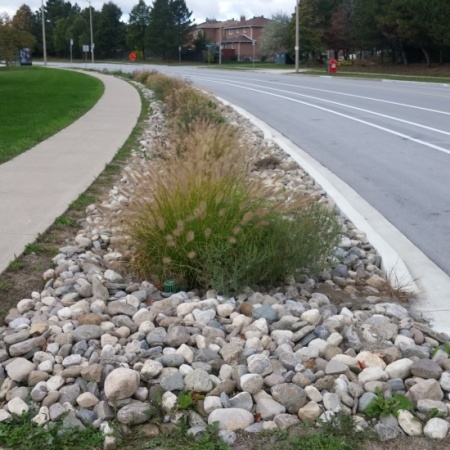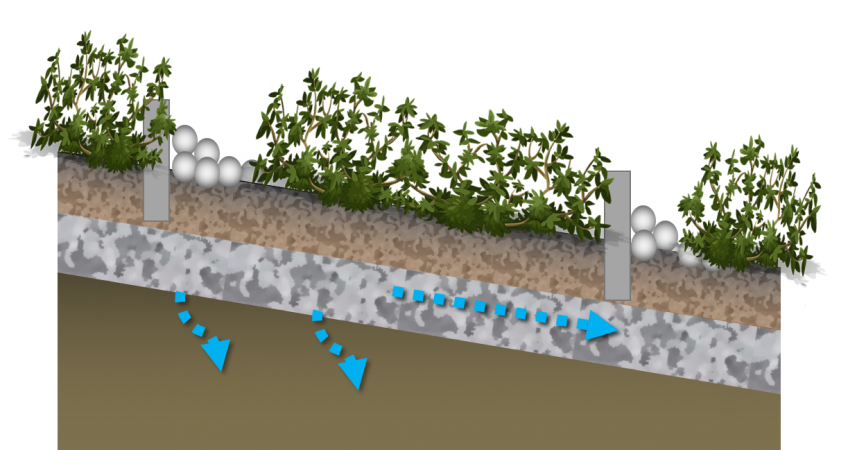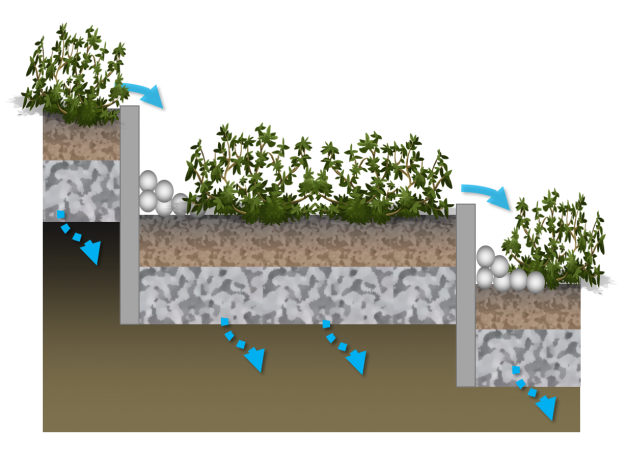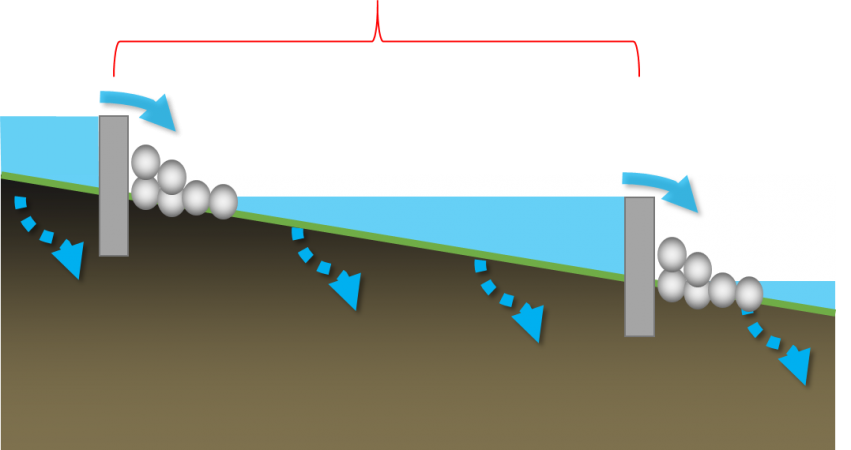Swales
This article is about installations designed to capture and convey surface runoff along a vegetated channel.
Overview[edit]
Swales are linear landscape features consisting of a drainage channel with gently sloping sides. Underground they may be filled with engineered soil and/or contain a water storage layer of coarse gravel material. Two variations on a basic swale are recommended as low impact development strategies, although using a combination design of both may increase the benefits:
Bioswales are sometimes referred to as 'dry swales', 'vegetated swales', or 'water quality swales'. This type of structure is similar to a bioretention cell but with a long linear shape (surface area typically >2:1 length:width )
Enhanced Grass Swales are a lower maintenance alternative, but generally have lower stormwater management potential. The enhancement over a basic grass swale is in the addition of check dams to slow surface water flow and create small temporary pools of water which can infiltrate the underlying soil.
Swales are an ideal technology for:
- Sites with long linear landscaped areas, such as parking lots
- Connecting with one or more other types of LID
| Property | Bioswale | Enhanced Grass Swale |
|---|---|---|
| Surface water | Minimal
Any surface flow can be slowed with check dams |
Ponding is encouraged with check dams |
| Engineered soil | Biomedia required | Amendment preferable when possible |
| Underdrain | Common | Uncommon |
| Maintenance | Medium to high | Low |
| Stormwater benefit | High | Medium |
| Biodiversity benefit | Increased with native planting | Lower |
The fundamental components of a swale are:
- Graded channel
- Planting
Additional components may include:
- Biomedia - an engineered soil mix
- Underdrain with clean out and inspection ports
- Impermeable membrane to prevent infiltration to soils below
- Turf reinforcement to prevent scour
- Check dams
Planning Considerations[edit]
A linear design (surface area typically >2:1 length:width) is a common feature of a swales:
- An absolute minimum width is 0.6 m is required for bioswales to have healthy plant growth, and to facilitate construction.
- Grassed swales are usually mown as part of routine maintenance, so the cross section will be parabolic or trapzoidal in shape. The minimum width for this type is 2 m.
Swales may be graded along longitudinal slopes between 0.5 - 6 %:
- Check dams are required on slopes > 3 %.
- Slopes > 6% can accommodate a series of stepped bioretention cells, each overflowing into the next with a weir.
<panelSuccess>
</panelSuccess>
Design[edit]
Pretreatment and inlets
To minimize erosion and maximize the functionality of the swale, sheet flow of surface water should be directed into the side of the BMP. Gravel diaphragms, vegetated filter strips and shallow side slopes are ideal. Alternatively, a series of curb inlets can be employed, where each has some form of flow spreading incorporated. Single point inflow can cause increased erosion and sedimentation which will damage vegetation and contribute to BMP failure. Again, flow spreading devices can mitigate these processes, where concentrated point inflow is required.
Check dams
Check dams are a feature of enhanced swales. They promote infiltration and evaporation by promoting limited ponding. To design check dams into a swale:
- The height of each dam is determined by the depth of ponded water that will infiltrate in 24 hours. The infiltration may be into the native soils, into biomedia, or some other soil amendment may be proposed in the design.
- Dams are usually installed between 10-20 m along the swale. They are distributed such that the crest of each dam is at approximately the same elevation as the toe of the upstream dam. If the slope along the swale varies, so should the distance between the dams.
- Dams may be constructed of any resilient and waterproof material, including: rock gabions, earth berms, coarse aggregate or rip-rap, concrete, metal or wood.
- Energy dissipation and erosion control measures should be installed in the 1 - 2 m downstream of each dam. Examples include large aggregate or turf reinforcement
Other components
<panelSuccess>
</panelSuccess>
Performance[edit]
<h4blue>Bioswales</h4blue> While few field studies of the pollutant removal capacity of bioswales are available from cold climate regions like Ontario, it can be assumed that they would perform similar to bioretention cells. Bioretention provides effective removal for many pollutants as a result of sedimentation, filtering, plant uptake, soil adsorption, and microbial processes. It is important to note that there is a relationship between the water balance and water quality functions. If a bioswale infiltrates and evaporates 100% of the flow from a site, then there is essentially no pollution leaving the site in surface runoff. Furthermore, treatment of infiltrated runoff will continue to occur as it moves through the native soils.
| LID Practice | Location | Runoff Reduction* | Reference |
|---|---|---|---|
| Bioswale without underdrain | Washington | 98% | Horner et al. (2003)[1] |
| Scotland | 94% | Jefferies (2005)[2] | |
| Bioswale with Underdrain | Maryland | 46 to 54% | Stagge (2006)[3] |
| Bioretention without underdrain | China | 85 to 100%* | Gao, et al. (2018)[4] |
| Connecticut | 99% | Dietz and Clausen (2005) [5] | |
| Pennsylvania | 80% | Ermilio (2005)[6] | |
| Pennsylvania | 70% | Emerson and Traver (2004)[7] | |
| Bioretention with underdrain | |||
| Ontario | 64% | CVC (2020)[8] | |
| Maryland and North Carolina | 20 to 50% | Li et al. (2009) [9] | |
| North Carolina | 40 to 60% | Smith and Hunt (2007)[10] | |
| North Carolina | 33 to 50% | Hunt and Lord (2006) [11] | |
| Runoff Reduction Estimate* | 85% without underdrain;
45% with underdrain | ||
<h4blue>Enhanced grass swales</h4blue>
Incentives and Credits[edit]
In Ontario
City of Mississauga
The City of Mississauga has a stormwater management credit program which includes RWH as one of their recommended site strategies[1].
LEED BD + C v. 4
SITES v.2
See Also[edit]
External Links[edit]
| SEND US YOUR QUESTIONS & FEEDBACK ABOUT THIS PAGE |
- ↑ Horner RR, Lim H, Burges SJ. HYDROLOGIC MONITORING OF THE SEATTLE ULTRA-URBAN STORMWATER MANAGEMENT PROJECTS: SUMMARY OF THE 2000-2003 WATER YEARS. Seattle; 2004. http://citeseerx.ist.psu.edu/viewdoc/download?doi=10.1.1.365.8665&rep=rep1&type=pdf. Accessed August 11, 2017.
- ↑ Jefferies, C. 2004. Sustainable drainage systems in Scotland: the monitoring programme. Scottish Universities SUDS Monitoring Project. Dundee, Scotland. https://www.climatescan.nl/uploads/projects/8126/files/1277/SNIFFERSR_02_51MainReport.pdf
- ↑ Stagge, J. 2006. Field evaluation of hydrologic and water quality benefits of grass swales for managing highway runoff. Master of Science Thesis, Department of Civil and Environmental Engineering, University of Maryland. https://drum.lib.umd.edu/items/42be6ce6-e4ef-4162-a991-c273607d422d
- ↑ Gao, J., Pan, J., Hu, N. and Xie, C., 2018. Hydrologic performance of bioretention in an expressway service area. Water Science and Technology, 77(7), pp.1829-1837.
- ↑ Dietz, M.E. and J.C. Clausen. 2005. A field evaluation of rain garden flow and pollutant treatment. Water Air and Soil Pollution. Vol. 167. No. 2. pp. 201-208. http://citeseerx.ist.psu.edu/viewdoc/download?doi=10.1.1.365.9417&rep=rep1&type=pdf
- ↑ Ermilio, J.F., 2005. Characterization study of a bio-infiltration stormwater BMP (Doctoral dissertation, Villanova University). https://www1.villanova.edu/content/dam/villanova/engineering/vcase/vusp/Ermilio-Thesis06.pdf
- ↑ Emerson, C., Traver, R. 2004. The Villanova Bio-infiltration Traffic Island: Project Overview. Proceedings of 2004 World Water and Environmental Resources Congress (EWRI/ASCE). Salt Lake City, Utah, June 22 – July 1, 2004. https://ascelibrary.org/doi/book/10.1061/9780784407370
- ↑ Credit Valley Conservation. 2020. IMAX Low Impact Development Feature Performance Assessment. https://sustainabletechnologies.ca/app/uploads/2022/03/rpt_IMAXreport_f_20220222.pdf
- ↑ Li, H., Sharkey, L.J., Hunt, W.F., and Davis, A.P. 2009. Mitigation of Impervious Surface Hydrology Using Bioretention in North Carolina and Maryland. Journal of Hydrologic Engineering. Vol. 14. No. 4. pp. 407-415.
- ↑ Smith, R and W. Hunt. 2007. Pollutant removals in bioretention cells with grass cover. Proceedings 2nd National Low Impact Development Conference. Wilmington, NC. March 13-15, 2007.
- ↑ Hunt, W.F. and Lord, W.G. 2006. Bioretention Performance, Design, Construction, and Maintenance. North Carolina Cooperative Extension Service Bulletin. Urban Waterways Series. AG-588-5. North Carolina State University. Raleigh, NC.



